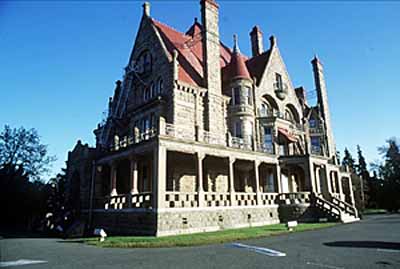Craigdarroch National Historic Site of Canada
Victoria, British Columbia

General view
© Parks Canada Agency / Agence Parcs Canada, J. Butterill, 1994.
Address :
1050 Joan Crescent, Victoria, British Columbia
Recognition Statute:
Historic Sites and Monuments Act (R.S.C., 1985, c. H-4)
Designation Date:
1992-06-04
Dates:
-
1887 to 1890
(Construction)
Event, Person, Organization:
-
Robert Dunsmuir
(Person)
-
Craigdarroch Military Hospital
(Organization)
-
Victoria College
(Organization)
-
Victoria Conservatory of Music
(Organization)
-
Warren H. Williams
(Architect)
-
Arthur L. Smith
(Architect)
-
Thomas Moffat
(Builder)
-
John Mortimer
(Builder)
Other Name(s):
-
Craigdarroch
(Designation Name)
-
Dunsmuir Castle
(Other Name)
-
Craigdarroch Castle
(Other Name)
Research Report Number:
1970-17, 1992-10
Plaque(s)
Existing plaque: 1050 Joan Crescent, Victoria, British Columbia
Built for coal magnate Robert Dunsmuir, Craigdarroch symbolized the desire of late 19th-century industrialists to assert their social position through conspicuous displays of wealth. Completed in 1890, the eclectic mansion features exquisite detailing in stone, stained glass, wrought iron and fine woods. Designers, craftsmen and materials were drawn from all over North America, marking a new age in construction made possible by transcontinental rail systems. This imposing landmark is among the largest and most ornate 19th-century mansions in Western Canada.
Description of Historic Place
Situated on the summit of the highest hill adjacent to downtown Victoria, British Columbia, Craigdarroch National Historic Site of Canada is a well-known and prominent landmark. Its Scottish Baronial design combines an eclectic fusion of elements borrowed from various architectural styles to evoke the romantic image of a hilltop castle. Built between 1887 and 1890, the castle is distinguished by its distinctive combination of materials, asymmetrical massing with a strong vertical emphasis, steeply-pitched picturesque roofline, and rich contrast of materials, colours and details. The building occupies a remnant of the original 11-hectare (28 acres) Dunsmuir estate and dominates the surrounding Rockland residential area of Victoria. The designation refers to the house on its legal lot as of 1992.
Heritage Value
Craigdarroch was designated a national historic site of Canada in 1992 because: it is an imposing landmark and a fine and early example of an eclectic mansion in the west; and, it is illustrative of an age when the conspicuous display of wealth was the accepted norm.
Occupying a hill overlooking downtown Victoria, Craigdarroch’s dramatic profile was purposefully designed to assert the wealth and social stature of its original owner, Robert Dunsmuir, a wealthy industrialist who had amassed his fortune from Vancouver Island coal. Craigdarroch epitomizes the “bonanza castle,” a term used to describe oversized mansions built as symbols of success for wealthy North American industrialists during the late 19th and early 20th centuries.
No expense was spared to ensure that Craigdarroch was the largest, most elaborate mansion in western Canada. Architect Warren H. Williams combined elements from a variety of architectural styles to create a dramatic design that was intended to evoke the impression of a castle from Dunsmuir’s native Scotland. The high level of craftsmanship evident in the exterior masonry and detailing is also evident in the wall and floor surfaces, stained glass, and joinery found throughout the interior. The combination of native and imported materials—British Columbia sandstone and granite, locally manufactured wrought iron, Italian marble and Vermont slate, terracotta tile from California, and imported interior wood panelling—was unprecedented in western Canada at the time, and established new standards for opulence within the region. Craigdarroch is one of the earliest, most flamboyant and best preserved of the bonanza castles built in Canada.
Craigdarroch subsequently housed the Craigdarroch Military Hospital (1919-21), Victoria College (1920-1946) and the Victoria Conservatory of Music (1968-79). It is now operated as a house museum.
Source: Historic Sites and Monuments Board of Canada, Minutes, June 1992.
Character-Defining Elements
Aspects of this site which contribute to its heritage value include: its hill-top location which makes it clearly visible from downtown Victoria, especially from Fort Street, and which affords sightlines from the building towards the Juan de Fuca Strait, Olympic Mountains, Sooke Hills, Mount Douglas and Mount Tolmie; the mix of stylistic elements deriving from Jacobean (pedimented dormers, balconettes, corbelling), Queen Anne Revival (variations in colour and texture), Romanesque Revival (window detailing, circular tower and stonework), and Chateau (steep hipped roof, round spires and decorated gables), architectural vocabularies which convey the eclecticism characteristic of late Victorian architecture; the historic exterior building materials, including grey granite (foundation and staircases), pink granite (verandah and entrance columns), grey sandstone (exterior walls, eaves and pediment trim, chimneys), Vermont red slate (roof surfaces), terracotta (roof ridge and hip caps), lead (balconette decks); the exterior forms and elements including the carriage entrance, circular tower, tower balcony, circular bay, verandah, fenestration, carved stone capitals and column details, brackets, finials, and urns; the original interior plan and spatial organization which creates separate spheres for public and private activities and conveys a hierarchy of space from public rooms to private family chambers and service areas; the original interior materials and craftsmanship, including fireplaces, wood and tiled floor surfaces, imported wood panelling in main hall, library and stairwell, stained glass windows, fireplaces, doors, mouldings and carved details such as thistle motifs and moral inscriptions, built-ins, elaborate plasterwork in the main hall, original painted ceiling surfaces and architectural hardware; the original elements that reflect luxury features of a Victorian mansion, including spacious bathrooms, generous natural lighting, and labour-saving devices such as a laundry chute and dumbwaiter; its setting within a landscaped garden.